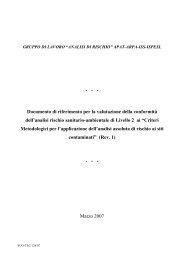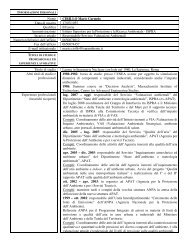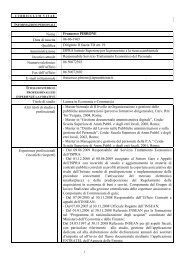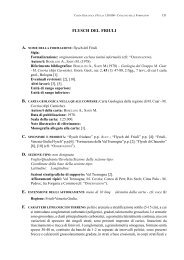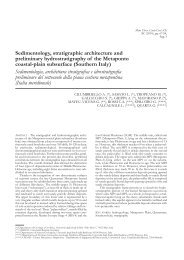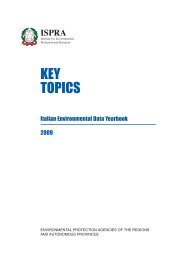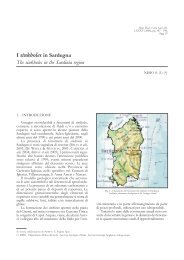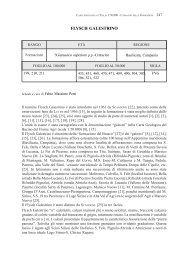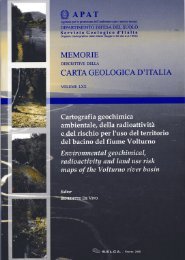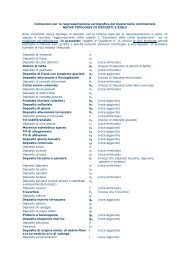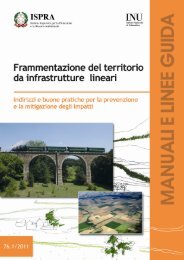Guidebook - Ispra
Guidebook - Ispra
Guidebook - Ispra
Create successful ePaper yourself
Turn your PDF publications into a flip-book with our unique Google optimized e-Paper software.
THE APULIA CARBONATE PLATFORM-MARGIN AND SLOPE, LATE JURASSIC TO<br />
EOCENE OF THE MAIELLA MT. AND GARGANO PROMONTORY:<br />
PHYSICAL STRATIGRAPHY AND ARCHITECTURE P18<br />
2002). After a period (Valanginian p.p.-Aptian p.p.)<br />
of normal platform and margin productivity and<br />
evolution, the ACP margin and the adjacent slope<br />
suddenly became inactivate during the early Aptian<br />
(Cobianchi et al., 1997; Bosellini et al., 1999). This<br />
event coincides with a relatively abrupt change in<br />
the open marine setting: the pelagic coccolith-rich<br />
white lime mudstones and chert of the Maiolica 2<br />
Fm are overlain by the Marne a Fucoidi Fm, a marly<br />
and shaly succession, with episodic organic carbonrich<br />
black shales (Cobianchi et al., 1997, 1999). The<br />
black shales correspond to a well known anoxic event<br />
occurred on a global scale and related to a change in<br />
the oceanographic and climatic conditions (Schlanger<br />
and Jenkyns, 1976; Jenkyns, 1980). Toward the end<br />
of the Albian and during the Cenomanian, a series of<br />
relative sea-level lowstands repeatedly exposed the<br />
carbonate platforms of the Southern Apennines and<br />
of the Apulian foreland to subaerial conditions, from<br />
the Maiella Mountain (Accarie et al., 1989; Eberli<br />
et al., 1993), to Lazio and Campania (Crescenti and<br />
Vighi, 1970; D’Argenio et al., 1987; Carannante et al.,<br />
1992; Ruberti, 1993), Gargano and Murge (Crescenti<br />
and Vighi, 1964; Mindszenty et al., 1995). The<br />
associated stratigraphic hiatuses, also documented<br />
by well-known bauxite deposits (D’Argenio and<br />
Mindszenty, 1991, 1992), are confi ned between the<br />
Albian p.p. and the early Turonian p.p. time interval.<br />
In the Gargano area, pronounced margin failures and<br />
consequent deposition of huge megabreccia bodies<br />
along the slope and base-of-slope belt were coeval<br />
with the general emergence and karst development<br />
of the southern Apennine carbonate platforms and<br />
also other platforms around the world (Grötsch et<br />
al., 1993). However, according to Crescenti and<br />
Vighi (1964), the bauxite-related unconformity of<br />
Gargano is late Cenomanian-Turonian p.p. (see<br />
discussion in Bosellini et al., 1999, pp. 1248-1249).<br />
The triggering mechanisms of the Gargano collapses<br />
might be related to seismic shocks associated with<br />
the incipient uplift of Apulia (linked to migration<br />
of intraplate stress according to Mindszenty et<br />
al., 1995), which culminated with its generalized<br />
emersion in Cenomanian-Turonian times. According<br />
to seismic profi les, it seems possible that the entire<br />
ACP margin was indented by several scallop features<br />
(Figure2). From Turonian until the late Santonian<br />
the margin was reactivate, the deep scallops sutured<br />
and exportation of bioclastic deposits (Monte Acuto<br />
Fm) continued through this time interval. Another<br />
stop in the exportation along the slope of platformderived<br />
sediments occurs in the late Santonian-Early<br />
Campanian (Luciani and Neri, 1994). At least 50<br />
m of pelagic lime mudstones with cherts divide in<br />
two parts the Monte Acuto Fm. Recently, in the<br />
Apricena area, pelagic sediments of Late Santonian<br />
age (Dicarinella asymetrica Zone), have been<br />
documented on top of previous inner platform facies<br />
of the Altamura Limestone (Morsilli et al., 2003). A<br />
signifi cant landward retreat of the margin of the ACP<br />
during early Campanian times is also recorded in the<br />
Fasano-Ostuni area, some 200 km to the southeast<br />
(Murge, Figure2) (Pieri and Laviano, 1989;) and in the<br />
Adriatic offshore (De Alteriis and Aiello, 1993). This<br />
events testify the partial drowning of some sector of<br />
the ACP (Early Eocene?). Finally, in Paleocene? time,<br />
new catastrophic failures occurred on the margin of<br />
the Eocene platform. A basal megabreccia (Grottone<br />
Megabreccia) followed by Lutetian clinostratifi ed<br />
deposits of the Monte Saraceno Limestone and<br />
bioclastic turbidites (Peschici Fm) were deposited<br />
around (Vieste-Peschici area and Monte Saraceno)<br />
the Gargano Promontory.<br />
Figure 22 - Late Jurassic-Early Cretaceous facies associations of the Gargano Promontory from the inner platform to<br />
the basin (modifi ed after Morsilli and Bosellini, 1997).<br />
17 - P18<br />
Volume n° 3 - from P14 to P36



